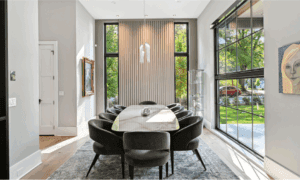In Central Arizona, where varied terrain is common, retaining walls are not only functional but can also be integral elements of landscape design. These structures are essential for managing sloped lands, preventing erosion, and creating usable garden spaces. This article explores the latest innovations in retaining wall design and how they can be effectively used in landscape architecture to address the unique challenges of sloped terrains.
Understanding the Function of Retaining Walls
Retaining walls serve a critical role in landscape design, particularly in areas with sloped terrains. Their primary function is to hold back soil, preventing it from sliding or eroding, which is crucial for protecting structures and other landscaping elements. Beyond this functional aspect, retaining walls can also enhance the aesthetic appeal of a property and increase its usability by creating level areas for gardening, patios, or other outdoor activities.
Materials and Techniques in Modern Retaining Walls
- Concrete Blocks: One of the most popular materials for constructing retaining walls is concrete blocks. These blocks are engineered for strength and durability, and they come in various shapes and sizes that can be used to create visually appealing designs.
- Natural Stone: For those seeking a more organic look, natural stone is a favored choice. It blends well with the natural landscape and provides a robust solution that withstands the elements. Each stone piece is unique, giving each wall a distinct character.
- Gabion Walls: Gabion walls, made from wire cages filled with rocks or rubble, are gaining popularity due to their strength, durability, and permeability. These walls also offer an ecological benefit by allowing water to filter through, reducing hydrostatic pressure.
- Poured Concrete: For a sleek, modern look, poured concrete walls are often used. They provide a smooth, continuous surface that can be painted or finished in various ways to complement the surrounding landscape.
- Wood: While not as durable as stone or concrete, wood can be used for shorter retaining walls and adds a warm, natural element to garden landscapes. It is particularly popular in settings where a rustic appearance is desired.
Incorporating Retaining Walls into Landscape Design
Retaining walls offer unique opportunities for creative landscaping Central Arizona. They can be used to create terraced gardens, which are not only beautiful but also help manage water runoff and soil erosion. Integrating built-in seating or lighting into retaining walls can enhance their functionality and aesthetic appeal, making them focal points of garden design.
Considerations for Building Retaining Walls
When planning a retaining wall, several factors must be considered:
- Soil Type: The type of soil affects the design and construction of a retaining wall, particularly its foundation and drainage needs.
- Wall Height: Taller walls require careful engineering to ensure stability and may need additional reinforcement.
- Drainage: Proper drainage is critical to prevent water from building up behind the wall, which can lead to pressure that compromises the wall’s integrity.
- Permits and Regulations: Depending on the location and height of the wall, building permits may be required, and there may be specific codes and regulations that need to be followed.
Conclusion
Modern retaining walls are not only practical for managing sloped terrains but can also significantly enhance the landscape’s beauty and functionality. With a variety of materials and innovative designs available, these walls can be integrated into nearly any landscaping project, providing solutions that are both effective and visually appealing. Homeowners and designers in Central Arizona can leverage these solutions to transform challenging landscapes into stunning outdoor living spaces.
Read More From Techbullion



































